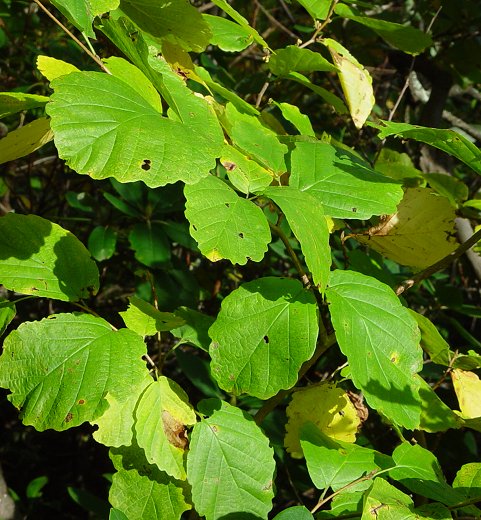Hamamelis virginiana L.
Eastern Witch-Hazel

Native
CC = 9
CW = 3
MOC = 10
© DETenaglia
Hamamelis virginiana L.Eastern Witch-Hazel | |
 |
Native CC = 9 CW = 3 MOC = 10 |
© DETenaglia |
|
Family - Hamamelidaceae Habit - Shrubs to 6 m tall, suckering but without underground runners.
Stems - Twigs sparsely to moderately stellate-hairy. Leaves - Alternate, petiolate, simple, stipulate, turning yellow to orangish yellow and generally falling promptly in the autumn. Petioles 7-18 mm long. Leaf blades 9-15 cm long, 5-10 cm wide, ovate to obovate, the base strongly asymmetrical, rounded to cordate on 1 side, narrowed on the other, the tip broadly and bluntly tapered or narrowed, the undersurface pale green but not glaucous.
Inflorescence - Stalked axillary clusters of mostly 3 flowers.
Flowers - faintly fragrant. Petals 15-20 mm long when fresh (shrinking to 8-12 mm long in the herbarium), generally yellow, rarely reddish. Staminodes strongly broadened toward the tip.
Flowering - September - December. Habitat - Wooded slopes, flats, and creek banks, on limestone and granite substrate. Origin - Native to the U.S. Other info. - This species is fairly rare in Missouri, only being found in a few eastern Ozark counties. Beyond Missouri it is found extensively both to the south and to the east. The plant is easy to ID in the field, especially while in flower, because of its unique leaves and distinct flowers. This is a shrubby tree that can have multiple stems from the base and can reach 4 m tall. Photographs taken at Pilot Knob State Park, NC., 10-20-02 (DETenaglia); also at Taum Sauk State Park, Iron County, MO, 10-25-2024 (KBildner). |